Dealing with Black Sands:
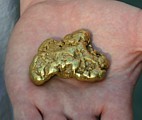
.
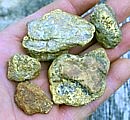
Dealing with Black Sands |
 |
||
|
. |
Want to get all the gold out of your black sands? There is often some very small sized gold there and it can be a lot of work to get all the gold out. We work hard to capture the gold and we don't want to throw the fine gold away as it can be valuable. There are a lot of different options, and in the article below I'll take a look at all of the best known possibilities for getting the gold and other valuable minerals out of your black sands and producing a clean, saleable placer gold product. Take a look at the following information....... |
 |
|
Every
placer miner has to deal with it in one form or another, and some locations have it far
worse than others, but nearly every placer has at least some of it: black sand. It
collects in our concentrates and gets in the way of recovering our fine gold. Some
prospectors worry about getting every speck of gold and save it in buckets until they have
tons – others take all the gold they can conveniently remove and then toss out the
rest. So what is this mysterious stuff and what should we do about it? Lets take a look at
black sands and the best ways to extract all the gold that is reasonable to get, and our
options for recovering that gold. The sand, rocks and gravels in the
placer deposits we work have a density of about 2.5 to 3. Gold on the other hand, has a
density of 19.3 when pure. That difference is what makes all the gravity methods of
capturing gold work – whether it’s a simple pan, or a sluice box, dredge, dry
washer, table or jig, that big difference in density is what makes working with placers
pretty easy. However, these gravity-based methods are not just specific to gold –
they capture all the heavy materials in the placer and concentrate them, including black
sands. The frustrating thing about black sand is that while it is relatively easy to
separate the normal sand and gravel from the gold, it much more difficult to separate the
small sized gold from the black sand and other concentrates. There are many methods to
accomplish this job – some a lot more efficient than others. |
||
| Black sands are heavy, which is why they
collect in your pan, dry washer or sluice. They have density of about 5, meaning that
those black particles are about 5 times heavier than water. Perhaps the first question
about black sands is along the line of “what is this stuff?”
Normally, most of black sand
is made up of two crystalline oxides of iron:
magnetite and
hematite. Hematite has a
density of 5.3, and magnetite a density of 5.2. Its not surprising that two iron minerals
dominate the concentrates, as iron is the fourth most common element in the earth’s
crust. Both are found in a number of different types of rocks, and when
these two materials occur in great enough concentrations, they are important
iron ores. When rocks containing these minerals is weathered and eroded,
they collect in streams and drainages. Chemically, magnetite has a formula Fe3O4. Its crystalline structure places it in
the spinel family of minerals. It melts at 1538 C and has a density of 5.2. It’s
structure makes it highly magnetic. Hematite is not so chemically resistant as Magnetite,
and its chemical formula is Fe2O3. The little known secret about hematite is that it is
actually very slightly magnetic. Nothing like magnetite mind you, and most magnets will
not lift it, but it can be picked up with certain extremely strong rare
earth type magnets and we will
talk more about that important fact shortly. |
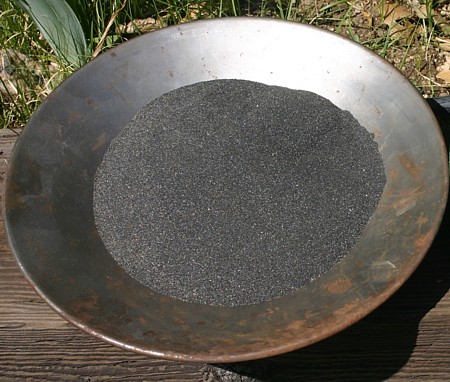 |
|
In
addition to magnetite and hematite, black sands may also contain small amounts of a lot of
different heavy minerals depending on the rock types in which you are working. Heavy
concentrates may or may not contain at least some of the following:
chromite (an ore of
chromium), Diamonds, platinum, gold bearing amalgam (lost by early day miners), lead (from
fishing weights and bullets), floured mercury,
cinnabar (a natural mercury ore),
sheelite
(tungsten ore),
zircon (a rare gem with a density of 4.7), garnets,
pyrite and
barite. The
proportions that you may find of these minerals or man-made products depend on the
specific location where you are prospecting. Some of these things, like diamonds, platinum
and amalgam, are valuable in their own right. Mercury and amalgam may contaminate the gold
you recover in your sluice box. The amount
of black sand and other heavy minerals, which you find associated with your placer gold,
varies a lot – there is not a simple direct correlation. There are places that are
loaded with black sand but have no gold. Conversely, there are also places that have good
quantities of gold but very little black sand. It seems like at least a little black
sand is found practically everywhere, so perhaps the next question is “where is all
this black sand coming from?” As I noted iron is the fourth most common element in
the earth’s crust, so some iron-bearing minerals are found in most rock types. They
are especially common in metamorphic and igneous rocks. Since gold deposits are often
associated with igneous and metamorphic rocks, it’s easy to see why we nearly always
find at least some black sands in our placers. So now that we know a bit about this stuff
and where it comes from, what are we supposed to do to get the gold out of it? |
||
First, many new
prospectors, believing that it somehow contains large quantities of “hidden”
precious metals, find black sand mysterious and incomprehensible. Often this leads to the
promotion of expensive and highly questionable treatments to “unlock” the
“invisible” values of black sand – including “special” assays,
strange leaching techniques, and “magic” fluxes. The truth is that most of the
values in black sands are simple free gold particles, which are recoverable by standard
gravity recovery methods. Any values truly locked into the black sand, surrounded by
minerals such as magnetite so that it cannot be recovered by normal gravity separation
systems, are typically very small. The amount of any truly “locked in” gold can
be scientifically determined by very meticulously recovering all the free gold possible
from a sample of black sand, making sure to carefully examine it under 10x magnification
to see that all the free gold has been removed, and then take that clean black sand and
run a standard fire assay on it. Do an assay before you invest money in any expensive
treatments, because in nearly all cases, this assay will show it is not economically
worthwhile to pursue any further treatment of the black sands, especially for the small
operator. |
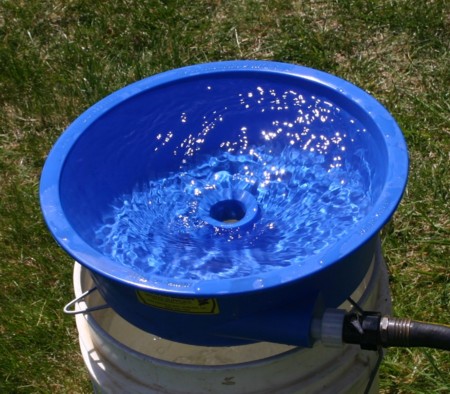 |
|
The answer as to how to best deal
with black sand depends on how much you are generating. If you are an individual
prospector who dredges or dry washes during weekends or while on vacation, you might
generate 20 to 200 pounds per year. If you just snipe with a pan or use a hand operated
sluice box, the amounts will be even less. On the other hand, if you are a large
commercial operator, you may produce tons of black sand, and the use of more sophisticated
equipment such as shaker tables will be justified. Lets take a look at both possibilities: Dealing with Small Quantities of Black Sands: This is the category into which most prospectors and weekend or seasonal miners fall – including me. I normally spend a week or two per year dredging, and combined with my other prospecting, I generate something around 20 to 40 pounds per year of black sands that need to be processed. Here are the techniques I use to go from concentrates fresh out of the sluice box, all the way to clean gold. At the end of each dredging day, I
clean up the front section of my 3 stage sluice box. About every other day I clean out
rear top section, and about once per week I clean out the undercurrent section of the
sluice box. Many new miners, worrying about loss of gold, clean up too often and this
takes away from the time they could be dredging and finding more gold. Sluice boxes on newer dredges are
well designed, and if your sluice is set up so that the gravel is not accumulating so much
that it buries the rifles nor running so fast that it sweeps the rifles and carpet clean,
then once a day clean up is all you should need on most store bought dredges. When operating properly, your
sluice will have about one inch of carpet showing between the gravel of the middle riffle
of the sluice and the one below it. |
||
| . | ||
| After dredging all day, I empty off my
sluice into a large plastic wash tub. I then screen those concentrates using a quarter
inch screen to get rid of the small rocks. Any gold that fails to go through a quarter
inch screen is a nice nugget. After a quick sort to find any coarse nuggets, the reject
rocks and pebbles are discarded. The next step is to pan through the remaining
concentrates. The point of this step is to remove the light sands which are in those
concentrates. Once I have panned through the fines so that the lighter sand is removed,
and I take out any pickers, flakes and small nuggets large enough to be worth removing by
hand. After all these larger pieces have been removed, all that remains is a small amount
of black sand, which contains all the fine sized gold and other heavy mineral
concentrates. I then put these concentrates into a container – lately I am using the
new plastic coffee cans. Don’t use metal cans to store wet black sand as the cans
rust and it will cause the black sand will harden up into a solid mass. I save and
accumulate this fine black sand and gold concentrate all season, waiting to process it all
at once at the end of the year. |
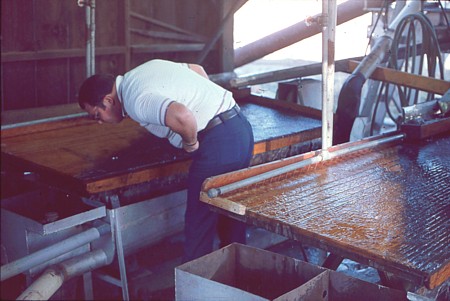 |
|
| Dry washing concentrates are
processed in a similar manner, depending on where I am camping. In locations where it is
easier to haul all the concentrates around than it is to haul all the water needed to
process them, I sometimes simply take all my dry wash concentrates home and process them
in a tub at the house. The clean black sand and fine gold is added to the black sand fines
obtained by dredging, sniping, or sluicing for final processing at the end of the
prospecting season. At the end of the prospecting year (which for me is late October or early November), I have accumulated something between 20 and 40 pounds of black sand concentrate. In my final clean up, I use a blue bowl hooked up to my garden hose. Careful screening is the key to success with the blue bowl. First I screen the concentrates with a 30 mesh screen. I pan down the coarse matter which is larger than 30 mesh, until there is only a few cups of this material. The minus 30 mesh material is then processed in the blue bowl. Processing this material in the blue bowl is not fast, but it does work. You can relax while you are doing it as not much attention is required once it is set up. I will add about a cup of black sand, then run the bowl for a few minutes, shut down the water flow and add another cup or so, etc. until I have gone through the entire amount of –30 mesh black sand. I do not take the material down to pure gold in the blue bowl, but it does remove the majority of the black sand. At this point, you are left with a cup or so of coarse material you panned down, and about 2 cups of fine gold and black sand. |
Recommended Metal Detectors For Gold Prospecting:
|
|
| The next step requires a very strong magnet
– you will need one of the new rare earth super magnets, and a good sized one with
about 50 pounds or more of pull. Now your normal horseshoe magnet made of iron alloys
simply will not do for this. The magnets sold by the most of the major prospecting shops
to separate out black sands will not do. Those old style magnets will pick up magnetite,
but not hematite. The new powerful rare earth super magnets are necessary because they
will pick up the hematite, which is only very slightly magnetic. The old magnets will pick
up around half of the black sand, but the super magnets will remove more than 95% of it
– and that makes a big difference! These magnets are so strong that you need to be
careful – you can get your fingers pinched and smacked as these super powerful
magnets attract steel objects from surprising distances and with great speed. |
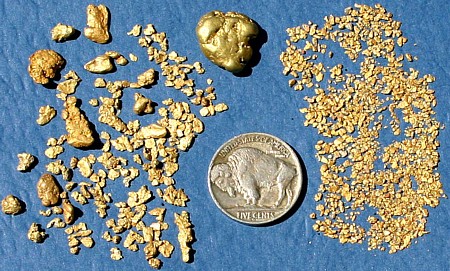 |
|
| Put the concentrates in a
plastic pan with about an inch or two of water – and spread them out into a thin,
even layer. Carefully pass the magnet over the black sand from about a half inch above the
black sand concentrates. On this first pass, do not touch or stir the concentrates with
the magnet. The trick is to make the magnetite and hematite jump up through the water to
the magnet leaving the gold behind. Remove the black sand that sticks to the magnet and
repeat. Eventually, when nearly all the magnetic minerals are removed, you can stir the
magnet through the remaining sand in order to pick up as much of the material as possible.
This is the part of the process where you need to examine the material on the magnet very
closely as a few particles of gold may be attached to magnetite and stick to the magnet. Repeat the process until no more magnetic minerals
can be removed. You can examine the material you removed in the last part of the process
with a magnifying glass to see how well you did. Remember a few tiny specs of gold may
only be less than a dime’s worth, so there is no great need to worry too much about
them. This process is done separately for both the 30+ mesh size and the –30 mesh
size. The next step is to dry both fractions separately. |
||
| . | ||
| After removal of all magnetic
minerals, only a few items normally remain. Gold, a few bits of lead, a garnet crystal or
two, etc. , may remain in the 30+ mesh size. This fraction is easily sorted with your
fingers when dry on a white sheet of paper. The trash is discarded and the gold (plus any
other valuables like platinum pieces) are saved. The smaller fraction may have some
non-magnetic black sand (commonly Chromite in many parts of California) and some
grey-white heavy sand of a very fine size (commonly Zircon). When dry these can also be
separated on a white sheet of paper – I normally use two sheets and with a little
careful blowing on these smaller final concentrates. With care and a little effort, using
this technique you can produce a clean gold product ready for sale or shipment to a
refiner. By the way, that 20 to 40 pounds of black sand typically yields around 2 or 3
pennyweight of fine gold, an amount well worth my time and effort. There are of course, a number of ways
to go about doing this final cleanup. Some folks use mercury to get the small gold. I have
done this in the past, but with the advent of the super magnet and the method outlined
above, in my opinion, mercury is simply no longer necessary for the individual prospector.
I like to stay away from the use of mercury, because the regulatory agencies go so crazy
about it. All in all, it is faster not to use it. There are spiral panning wheels, micro
sluices, tables and other devices for final clean up, they can do the job and all have
their proponents, but I use a blue bowl, mostly because it is cheap and it works. Sometimes (actually fairly often) my
gold needs to be treated to remove mercury stains that either happen in the river or
during recovery and processing. I prefer to use nitric acid for this, but some guys also
remove mercury by heating. Mercury vapors are toxic, so do this outside and be careful
– also be sure all the lead has been removed before heating, or you will have to use
nitric acid to separate the melted lead from the gold. Dealing with Larger Quantities of Black Sands from Commercial Operations: Even small commercial operations may generate more than 50 pounds of black sand per day, and processing equipment beyond the scope of the individual prospector is normally well justified. These operators commonly make use of shaking tables, large spiral wheels, mercury amalgamation and other commercial equipment to handle these larger volumes of black sand concentrates. It is always important for the commercial operator to keep close tabs
on his recovery equipment and do regular testing to make sure it is working properly. If
this is not done, the operator may well be loosing significant fine gold. During the early
1980’s I had the privilege to inspect and evaluate the operations of St. Joe
Minerals’ bucket line dredge operation at the Yuba Goldfields near Yuba City,
California. At the time, they delivered their entire finished black sand product to the
property owner after they had extracted all the gold that they believed was present in the
material. It turned out that they were not keeping good controls on their processing. The
property owner simply had one of his employees re-run the black sand over a finishing
style shaker table, and he recovered additional gold, in the amount of about 3 ounces per
day. Large operators who generate many tons of black sand each year may wish to consider additional steps beyond tables or spiral wheels such as reprocessing after crushing the black sands or leach extraction by cyanide. However, these options should be considered only after assaying the finished tailing material to see if cost and effort of any additional processing is justified. With the continued regulatory concern over mercury, it has lost much of its traditional place as a method of recovering fine gold, but it is still used, especially in less economically developed countries. For commercial operators in the US, mercury can be a significant environmental liability, as even comparatively small spills may be quite expensive to clean up. Mercury is still used by some small prospectors, and if
you do choose to use it be sure to take all necessary precautions. The use of mercury
potentially involves some inherent risk to your health if not done properly. In the final
step, the mercury is distilled in a retort in order to recover all the dissolved or
amalgamated metals. The fumes are toxic, and mercury chemicals can be absorbed through the
skin. Once Mercury is absorbed into the body, it is retained for a long period of time and
it attacks the central nervous system. I used to use mercury to recover my fine gold, but
the advent of the rare earth super magnet has convinced me its unnecessary for my efforts
to separate my beautiful placer gold from those nasty black sands. |
||
| . | ||
Want to know a little bit more about this crazy prospector guy? Well, here's a little bit more about me, and how I got into prospecting: Chris' Prospecting Story Interested in seeing more gold? Here are some interesting photos of beautiful Gold Nuggets I'm the associate editor for a well known Gold Mining Magazine - so check out their website for more information and my latest articles.